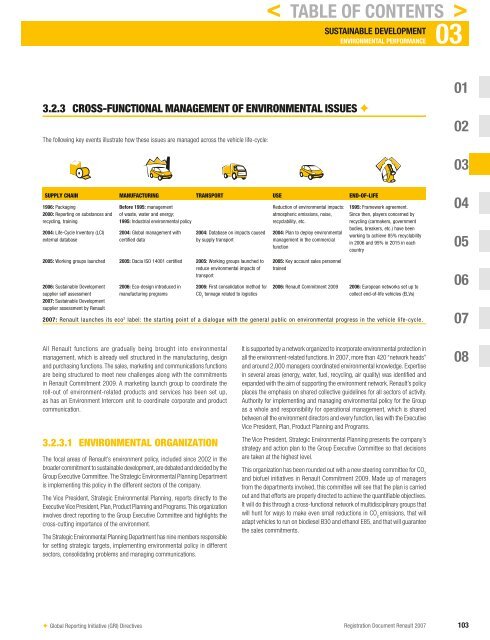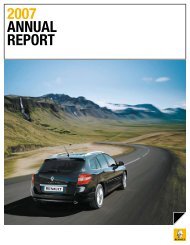2007 Interactive Registration Document - Renault
2007 Interactive Registration Document - Renault
2007 Interactive Registration Document - Renault
You also want an ePaper? Increase the reach of your titles
YUMPU automatically turns print PDFs into web optimized ePapers that Google loves.
3.2.3 CROSS-FUNCTIONAL MANAGEMENT OF ENVIRONMENTAL ISSUES ✦<br />
The following key events illustrate how these issues are managed across the vehicle life-cycle:<br />
SUPPLY CHAIN MANUFACTURING TRANSPORT USE END-OF-LIFE<br />
1996: Packaging<br />
2000: Reporting on substances and<br />
recycling, training<br />
2004: Life-Cycle Inventory (LCI)<br />
external database<br />
✦ Global Reporting Initiative (GRI) Directives<br />
Before 1995: management<br />
of waste, water and energy;<br />
1995: Industrial environmental policy<br />
2004: Global management with<br />
certified data<br />
2004: Database on impacts caused<br />
by supply transport<br />
2005: Working groups launched 2005: Dacia ISO 14001 certified 2005: Working groups launched to<br />
reduce environmental impacts of<br />
transport<br />
2006: Sustainable Development<br />
supplier self assessment<br />
<strong>2007</strong>: Sustainable Development<br />
supplier assessment by <strong>Renault</strong><br />
2006: Eco-design introduced in<br />
manufacturing programs<br />
2006: First consolidation method for<br />
CO 2 tonnage related to logistics<br />
Reduction of environmental impacts:<br />
atmospheric emissions, noise,<br />
recyclability, etc.<br />
2004: Plan to deploy environmental<br />
management in the commercial<br />
function<br />
2005: Key account sales personnel<br />
trained<br />
SUSTAINABLE DEVELOPMENT 03<br />
ENVIRONMENTAL PERFORMANCE<br />
1995: Framework agreement.<br />
Since then, players concerned by<br />
recycling (carmakers, government<br />
bodies, breakers, etc.) have been<br />
working to achieve 85% recyclability<br />
in 2006 and 95% in 2015 in each<br />
country<br />
2006: <strong>Renault</strong> Commitment 2009 2006: European networks set up to<br />
collect end-of-life vehicles (ELVs)<br />
<strong>2007</strong>: <strong>Renault</strong> launches its eco 2 label: the starting point of a dialogue with the general public on environmental progress in the vehicle life-cycle.<br />
All <strong>Renault</strong> functions are gradually being brought into environmental<br />
management, which is already well structured in the manufacturing, design<br />
and purchasing functions. The sales, marketing and communications functions<br />
are being structured to meet new challenges along with the commitments<br />
in <strong>Renault</strong> Commitment 2009. A marketing launch group to coordinate the<br />
roll-out of environment-related products and services has been set up,<br />
as has an Environment Intercom unit to coordinate corporate and product<br />
communication.<br />
3.2.3.1 ENVIRONMENTAL ORGANIZATION<br />
The focal areas of <strong>Renault</strong>’s environment policy, included since 2002 in the<br />
broader commitment to sustainable development, are debated and decided by the<br />
Group Executive Committee. The Strategic Environmental Planning Department<br />
is implementing this policy in the different sectors of the company.<br />
The Vice President, Strategic Environmental Planning, reports directly to the<br />
Executive Vice President, Plan, Product Planning and Programs. This organization<br />
involves direct reporting to the Group Executive Committee and highlights the<br />
cross-cutting importance of the environment.<br />
The Strategic Environmental Planning Department has nine members responsible<br />
for setting strategic targets, implementing environmental policy in different<br />
sectors, consolidating problems and managing communications.<br />
< TABLE OF CONTENTS ><br />
It is supported by a network organized to incorporate environmental protection in<br />
all the environment-related functions. In <strong>2007</strong>, more than 420 “network heads”<br />
and around 2,000 managers coordinated environmental knowledge. Expertise<br />
in several areas (energy, water, fuel, recycling, air quality) was identifi ed and<br />
expanded with the aim of supporting the environment network. <strong>Renault</strong>’s policy<br />
places the emphasis on shared collective guidelines for all sectors of activity.<br />
Authority for implementing and managing environmental policy for the Group<br />
as a whole and responsibility for operational management, which is shared<br />
between all the environment directors and every function, lies with the Executive<br />
Vice President, Plan, Product Planning and Programs.<br />
The Vice President, Strategic Environmental Planning presents the company’s<br />
strategy and action plan to the Group Executive Committee so that decisions<br />
are taken at the highest level.<br />
This organization has been rounded out with a new steering committee for CO 2<br />
and biofuel initiatives in <strong>Renault</strong> Commitment 2009. Made up of managers<br />
from the departments involved, this committee will see that the plan is carried<br />
out and that efforts are properly directed to achieve the quantifi able objectives.<br />
It will do this through a cross-functional network of multidisciplinary groups that<br />
will hunt for ways to make even small reductions in CO 2 emissions, that will<br />
adapt vehicles to run on biodiesel B30 and ethanol E85, and that will guarantee<br />
the sales commitments.<br />
01<br />
02<br />
03<br />
04<br />
05<br />
06<br />
07<br />
08<br />
<strong>Registration</strong> <strong>Document</strong> <strong>Renault</strong> <strong>2007</strong> 103




